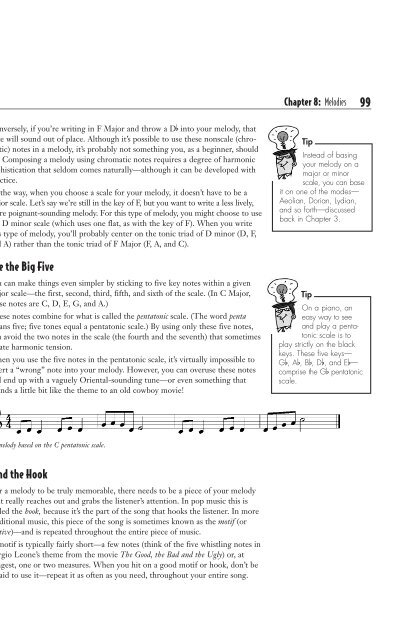The_Complete_Idiot%27s_Guide_To_Music_Theory
The_Complete_Idiot%27s_Guide_To_Music_Theory
The_Complete_Idiot%27s_Guide_To_Music_Theory
You also want an ePaper? Increase the reach of your titles
YUMPU automatically turns print PDFs into web optimized ePapers that Google loves.
Conversely, if you’re writing in F Major and throw a D♭ into your melody, that<br />
note will sound out of place. Although it’s possible to use these nonscale (chromatic)<br />
notes in a melody, it’s probably not something you, as a beginner, should<br />
try. Composing a melody using chromatic notes requires a degree of harmonic<br />
sophistication that seldom comes naturally—although it can be developed with<br />
practice.<br />
By the way, when you choose a scale for your melody, it doesn’t have to be a<br />
major scale. Let’s say we’re still in the key of F, but you want to write a less lively,<br />
more poignant-sounding melody. For this type of melody, you might choose to use<br />
the D minor scale (which uses one flat, as with the key of F). When you write<br />
this type of melody, you’ll probably center on the tonic triad of D minor (D, F,<br />
and A) rather than the tonic triad of F Major (F, A, and C).<br />
Use the Big Five<br />
You can make things even simpler by sticking to five key notes within a given<br />
major scale—the first, second, third, fifth, and sixth of the scale. (In C Major,<br />
these notes are C, D, E, G, and A.)<br />
<strong>The</strong>se notes combine for what is called the pentatonic scale. (<strong>The</strong> word penta<br />
means five; five tones equal a pentatonic scale.) By using only these five notes,<br />
you avoid the two notes in the scale (the fourth and the seventh) that sometimes<br />
create harmonic tension.<br />
When you use the five notes in the pentatonic scale, it’s virtually impossible to<br />
insert a “wrong” note into your melody. However, you can overuse these notes<br />
and end up with a vaguely Oriental-sounding tune—or even something that<br />
sounds a little bit like the theme to an old cowboy movie!<br />
A melody based on the C pentatonic scale.<br />
Find the Hook<br />
For a melody to be truly memorable, there needs to be a piece of your melody<br />
that really reaches out and grabs the listener’s attention. In pop music this is<br />
called the hook, because it’s the part of the song that hooks the listener. In more<br />
traditional music, this piece of the song is sometimes known as the motif (or<br />
motive)—and is repeated throughout the entire piece of music.<br />
A motif is typically fairly short—a few notes (think of the five whistling notes in<br />
Sergio Leone’s theme from the movie <strong>The</strong> Good, the Bad and the Ugly) or, at<br />
longest, one or two measures. When you hit on a good motif or hook, don’t be<br />
afraid to use it—repeat it as often as you need, throughout your entire song.<br />
Chapter 8: Melodies<br />
99<br />
Tip<br />
Instead of basing<br />
your melody on a<br />
major or minor<br />
scale, you can base<br />
it on one of the modes—<br />
Aeolian, Dorian, Lydian,<br />
and so forth—discussed<br />
back in Chapter 3.<br />
Tip<br />
On a piano, an<br />
easy way to see<br />
and play a pentatonic<br />
scale is to<br />
play strictly on the black<br />
keys. <strong>The</strong>se five keys—<br />
G♭, A♭, B♭, D♭, and E♭—<br />
comprise the G♭ pentatonic<br />
scale.


